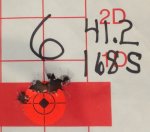Started working up some loads for a new JP medium contour .308 barrel/low mass bolt I just built up.
I had a couple of loads that gave me almost no vertical dispersion but kinda "stacked" five rounds horizontally at 100 yards. Winds less than 7 knots.
My question is:
a. does vertical stacking always mean that round is not in the node?
b. is horizontal "stacking" always an indication of poor trigger technique/followthrough?
Thanks for the replies!
I had a couple of loads that gave me almost no vertical dispersion but kinda "stacked" five rounds horizontally at 100 yards. Winds less than 7 knots.
My question is:
a. does vertical stacking always mean that round is not in the node?
b. is horizontal "stacking" always an indication of poor trigger technique/followthrough?
Thanks for the replies!




